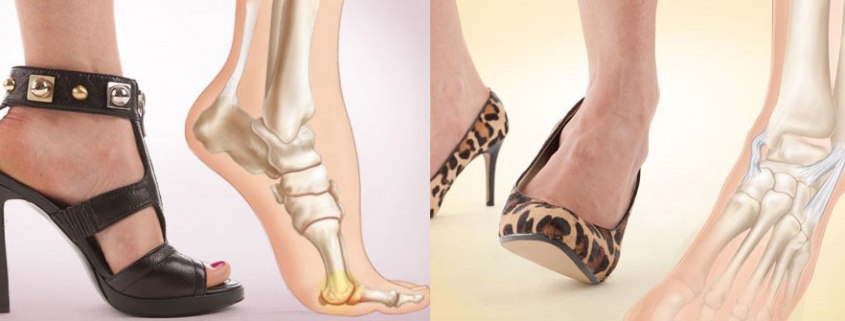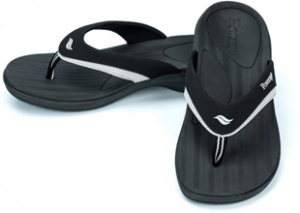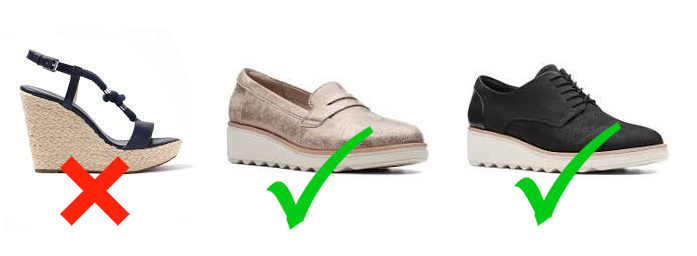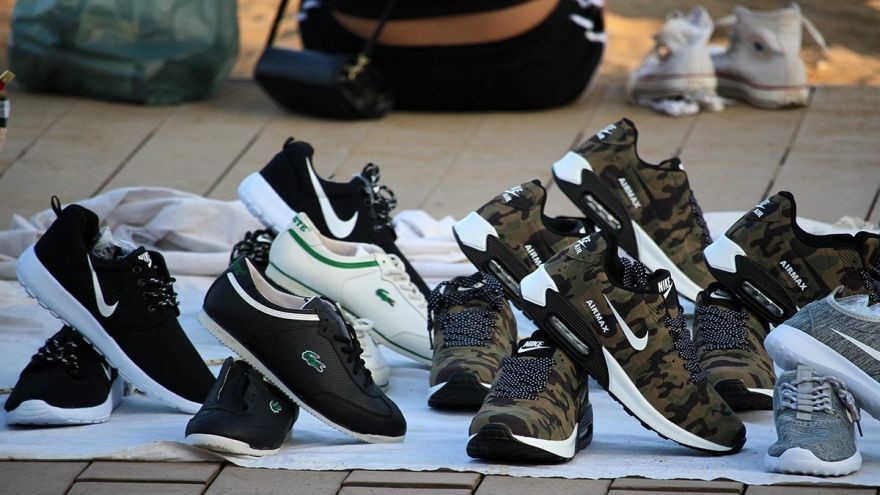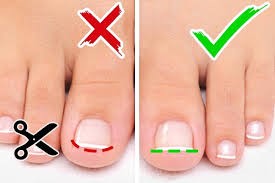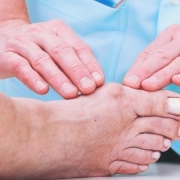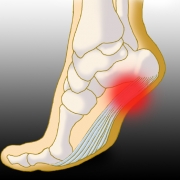Choosing the wrong shoes can cause more than just pain…
So here are some guidelines that will help you consider what’s best for your feet, the next time you need new shoes!
Podiatrists and Orthopaedic Surgeons agree…… shoes that are too tight, too loose or without enough support, can lead to unwanted stress on the feet, ankles, lower leg, hip and spine.
Ongoing pressure from ill fitting, shoddy footwear can cause pain and injuries that may limit or prevent your work, sports and hobbies.
5 Golden rules when searching for shoes
- Heel: Needs a broad base and be no longer than one-and-a-half inches
- Sole: Should be cushioned and have a good grip to prevent slipping
- Linings: Made of smooth, seam-free breathable materials, keep your feet fresh. Avoid nylon or plastic linings
- Toe box: Should be enough room for toes to wiggle. Make sure there’s half an inch of space between your longest toe and the end of the shoe.
Most importantly:-
There should be enough width in the shoe to accommodate your whole foot, without any pressure on the joints on the sides of your foot.
Always try to shop for shoes in the afternoon, as feet tend to swell a bit during the day.
Remember your foot type when you choose your shoes
If you have flat feet or high arches, you are more likely to get plantar fasciitis, a painful inflammation of the tissue along the bottom of your foot. It is the leading cause of heel pain. Without proper arch support you can have pain in your heels, arch and leg. You can also develop painful bunions and hammertoes. Podiatrist can provide custom inserts for your shoes. You can also buy generic supports too. For example: http://athrohab.co.uk/product/gel-insoles-plantar-fasciitis/
If you have high arches choose shoes with laces, buckles or hook and loop straps. Look for extra cushioning and a soft platform. Shoes with good arch support and a slightly raised heel can help keep your feet in fine form.
Using the wrong footwear can also cause the following…..
Athlete’s foot: A skin disease caused by a fungus that grows as result of damp environments such as sweaty feet; prevention includes wearing clean, airy shoes.
Bunions and corns: This bump (bunion) and thickened skin patch (corn) can be caused by shoes that are too tight or create pressure.
Hammer toes: This generally refers to the toe bending severely at a joint and can be caused by wearing shoes that are too tight.
The best and worst footwear
The support you get from the ground upwards has an impact on the alignment of your entire body. Well designed footwear is essential for providing good support around the foot and ankle.
The right footwear can help prevent foot, leg and back pain.
It is better to invest in footwear that is comfortable, supporting, safe, fits well, has a low broad heel, thin flexible sole, some kind of lace, strap or hook & loop system to ensure the shoe stays firmly attached to the foot to is comfortable, rather than high heels with flimsy straps, and pointy toes.
With older adults, shoes that are too-short or too narrow can lead to foot deformities and increase risk of weakness and falls as well as bunions, corns and calluses.
The wrong footwear…
Kick the high heel habit! Fashion shoes for men & women may look attractive, but they aren’t doing your body any favours.
High heels three-to four-inches high will change the alignment of your body, which puts extra stress on your legs, hips and back. Wearing high heels regularly causes the Achilles tendon to tighten and shorten, which can actually make it painful to wear flat shoes. High heels also create more pressure on the ball of your `foot, which causes the foot’s natural padding to thin and provide less cushion where you need it most. All of this extra pressure can also lead to calluses.Along with causing forefoot pain, high heels can result in Lordosis, an inward curving of the lower back that can lead to pain.
Pointed-toe shoes particularly with high heels, that scrunch your toes together. This can aggravate an existing bunion, and cause your toes to contract and eventually curl under permanently, leading a condition known as hammertoe.
Flip flops are popular summer footwear, especially on the beach. Flip flops with flat soles can lead to Plantar fasciitis and Achilles tendonitis. The condition, Plantar fasciitis is caused by the excessive pull of the plantar fascia, an arch-supporting ligament, causing pain and inflammation at the heel.
Achilles tendonitis is caused by poor mechanics of the foot, leading to overstretching of the tendon. This sometimes leads to bone spurs. The thong between the toes can cause irritation leading to blisters and infection. Long-term use of flipflops can also cause hammertoe as the toes constantly struggle to grip & hold the foot to the base of the footwear.
If you already have a mechanically unsound foot to begin with, wearing flip flops can actually lead to a host of lower extremity problems, such as arch pain, heel pain, ankle pain or knee pain.
Try to find a flip-flop made with thick cushioned soles and neoprene rubber upper area. Neoprene rubber is wet suit like material and minimizes the potential for blisters and other types of irritation.
Make sure the flip-flop has some raised arch support like the ones shown below. This will help distribute pressure more evenly.
Never wear flip flops for long distance walks, sporting activities or outside work!!
Ballet flats are as bad for your feet as flip flops because they, also provide little support. There is no arch system to help absorb the brunt of the pressure the feet endure every day.
Flexible shoes that you can bend and twist with ease are not going to be supportive enough. Shoes with good arch support will be difficult to manipulate.
Just remember, if you can twist and roll them.. Don’t buy them!
Wedge heels that are higher than 4 cm will start to cause similar problems as described in the High heels section above. The slight angle of wedges under 4 cm high will provide better support and balance.
The best footwear
Determining the “healthiest” shoe for any person has to take into account their age, health, walking and running habits, occupation, local environment and among many smaller considerations, personal budget.
Don’t change your footwear style suddenly
For example, some people accustomed to walking and running in traditional shoes who quickly change to minimal footwear may be at risk of injury. As will those who are heavy footed, who slam their feet down when they walk. Also, people with neuropathy who have loss of sensation in their feet, will probably hurt themselves if they wear a minimal shoe (sandal).
Change your shoe style gradually, NOT OVERNIGHT.
Leisure Trainers especially modern branded sports shoes are generally up to the job, well designed with good internal support, safe tread, and a cushioned sole…. most sports Leisure trainers only have a lifespan of six months or 500 miles due to the softer shoe materials used. If they’re worn out, you could be setting yourself up for injury. But always try on several different pairs, and compare different sorts. They all feel different.
Select a style where you can control the fastening mechanism (laces, hook & loop strap) to suit your foot shape. Don’t buy a bigger shoe size, trainers can often curl upwards and cause you to trip.
The choices are huge. Try on as many as you can before deciding.
Avoid buying brand fakes!
Don’t wear cheap fake label trainers, they simply aren’t the real deal and usually have a very short life. Generally you get what you pay for.
Mixing up your shoe choices
If you insist on wearing heels, regularly then switching footwear from high heels to lower heels will prevent muscles from becoming strained and will allow joints to load differently with a larger range of motion. A 2 inch heel is better than a 4 inch heel. Don’t wear them every day and don’t wear them if you are going to be on your feet for a long time. Choose chunky heels instead of skinny ones if you have flat feet.
There’s a shoe for that, so wear it!
Try to wear the right shoes for the occasion. Wear trainers or supportive footwear for any type of exercise or when you know you’ll spend long periods of time on your feet. If you run or play a specific sport three or more times a week then treat your feet to a shoe made for that activity.
Good running shoes, for example can help prevent heel pain, stress fractures and other foot problems from developing.
It is also important to replace shoes when they start to wear down.
Ease the stress
Be aware of your own body weight. Extra weight can lead to muscle fatigue as well as heel, arch and muscle pain.
Extra weight can change your foot structure leading to swelling in the foot and ankle as well as painful spurs (bumps) that grow on your foot bones.
Don’t go barefoot for too long
Being barefooted for long periods of time will put strain on your feet and can lead too plantar warts and athlete’s foot. Having your feet exposed to the elements can also lead to cuts.
Don’t cut corners
The best way to trim your toenails is to cut them straight across and not into the corners. That will lead to an ingrown nail which will become extremely painful over time.
You only get one set of feet in a lifetime
It is important to take care of them properly. Wearing the latest fashion shoe style isn’t worth the health risk of permanent foot damage with accompanying knee or hip pain.
Always consult your GP if you have any concerns about the condition of your feet. Don’t leave things to fester and get worse!
Like any other part of your body, see you doctor if you have pain or notice anything unusual. With that kind of care, your feet will flourish.

